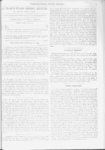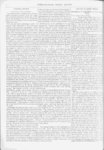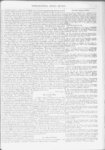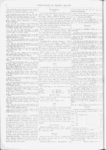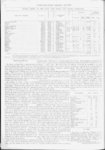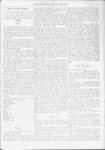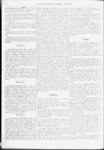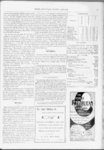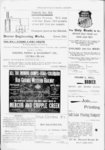| OCR Text |
Show INTER-MOUNTAI- MINING REVIEW. INTER-MOUNTA- IN AXI) WESTERN looted to MINING REVIEW. N MINING ttECOKI). tlie Mining: ami Smelting: Interests of ihe Published Weeklj- - by Alex Hyslop, 212 Inter-Mounta- in West. Atlas Block. TERMS: Payable in advance. I One ;i Year $2.00 Aiontlis l.oo 50 rrcMonths To foreign countries except Mexico and Canada, $3 per year, postage prepaid. Entered at tlie Salt Lake Postoilico as second-clas- s matter. Francisco Office; and Merchants Exchange, where this paper iskei t on file. Advertising contracts can by made with E. C. Dake. Agent. Chicago Office: 761 Monadnock Building. San 61 65 SALT LAKE CITY, UTAH Dec. 24, 1896. Tlie refractory ores of British Columbia are receiving the proper attention from experts on ore treatment, and C. S. Drummond of London claims he can treat the sulphide ores of the region at a The.Pelatan-Cleri- ci cost of i per ton. people are also trying to introduce their process, and promise to reduce the working charges to $1.25 per ton. If these people can do as they say, there is plenty of room for both outfits right here in Utah. Inter Mountain Industries is the title of a high-clas- s illustrated monthly magazine just issued from the press by Hon. R. W. Sloan and II. W. B. Kantner. The scope of the publication is to present the industries and resources of Utah in particular and the region in general to the public. The initial number contains some handsome cuts of Utah enterprises and men, and the Lehi sugar factory is made the subject of a special article. It will be rated publications of the West. among the high-clas- s inter-mounta- in The statement was made in this city recently, by a gentleman (who is thoroughly conversant with the mineral resources of Utah, that the greatest undeveloped mineral wealth within the borders of the state, is in the gilsonite and elaterite deposits on what is called the Uncompahgre reservation. This explains why David R. Francis of the St. Louis Gilsonite Company, recommends, in his capacity of Secretary of the Interior, that the lands be sold by the government in such a manner that he and his company can secure them to themselves. It should also be a reason why the public see that he dont get them. 3 for developed gold and copper properties is so strong and pronounced that he is unable to supply the demands of his clients. That eastern money is anxiously seeking investments in western mines, but that no demand is coming for prospects. This should be encouraging news to the owners of undeveloped properties in this state, anil should be an incentive, if any is needed, to lose no time in converting their prospects into mines. In Utah there are a number of good developed gold mines, but they are generally not for sale, At the same time there is probably no state in the Union, outside of California perhaps, that has gold in so wide an area, in so many different forms and ranging through so many varying grades of richness, as has Utah. From the Park Valley district near the Idaho line on the north to the San Juan mountains in the south, and from the Uintah mountains to the Nevada line, the entire area is a succession of gold bearing veins alternating with other minerals, but still leaving gold predominating. Moreover these conditions are only now beginning to be recognized facts, and there is every ground for the assertion that in five years time Utah will not rank second to any state in gold production. As we pointed out above, it should be an additional incentive to the opening up and developing of these treasures, to know that that there is a market at hand as soon as the prospect becomes a mine. SILVER AT PRESENT. While in Washington recently, Sir Moreton Frewen, the English political economist, discussed the silver question in its present phases, as follows: If India has plenty of produce to export wheat, cotton, jute and other things the balance of trade is favorable, so that India is a large consumer for her money metal, silver. As matters stand, however, India is importing wheat, and therefore exporting silver to pay for the wheat. If the famine is serious, as I fear, it may affect the exchanges not only with India, but with China and Japan, the cheaper rates for silver greatly stimulating the exports of both these countries.9' on the That explains how the United States gets double-sho- t turn. When India is suffering from famine, to relieve her stress she pushes out exports of manufactures, and her own reserves of silver to pay for the wheat she must have. This lowers the price of silver, a condition so favorable to China and Japan that it stimulates exports from those countries, as well as from India. ; . Under the decree of sale ordered by the United States Circuit Court on December 1st, the Oregon Short Line & Utah Northern railway will be sold in Salt Lake City on January 9th, 1S97. Meantime the reorganization committee is at work arranging details for the operation of the 1,400 miles of railway involved, when the sale shall have been effected. Whether the sale of the road will have the effect of opening the Ogden Gateway, as is so ardently hoped for by the competing lines of Utah, remains to be seen. There are many indications that point out a dominating Union Pacific influence in the reorganization committee, and if this influence is powerful enough, after the sale, the Short Line may tack considerable of from the Union Pacific. being segregated o On the other hand, an intelligent business policy with the line may be adopted, regardless of Union Pacific interests, in which case the lines would be thrown open for traffic from any of the connecting lines. The lines of the Short Line are laid in a geographical position that would make it the most powerful railway system in the j We-- t if it took and gave business with all connections, but this power is lost as long as it is operated as a feeder for the Union Pacific. minigentleman whose business is to carry through deals on ng property, and who has a large correspondence among the moneyed men of the East, informs the Review that the demand A CHEAP REDUCTION. In another column of this issue appears a description of the mill of the American Development and Mining company, which is situated near Gibbonsville, Idaho. If for no other reason, the article is interesting in the fact that it shows a remarkably low price per ton for the treatment of the ore; thirty cents per ton from the time the ore is dumped to the crushers until the gold brick is delivered. This, too, in a mill that is a combination of nearly all the mechanical and chemical processes. This example shows the wonderful advances that have been made in the fine art of extracting the values from ores, as compared with the early effoits of the mining and milling men of the West, who knew of scarcely any method except the amalgamation processes. In those days no large percentage of the values were saved, the operators generally being satisfied if enough was recovered from the ores to insure the financial success of the enterprise. The question arises, what is the limit to which the cost of mining and milling ores will be reduced? With the cyanide process the Geyser mine in Mercur treats its ores at a cost of $1.77 per ton from the face of the stope to the tailings established was dump, and yet the mill with which this record was a makeshift", not at all modern, nor was it originally located with the object of handling the ores at the lowest possible cost. With its mill remodeled this company expects to reduce the cost of mining and milling still further, and the realization of this hope means that ores of very low grade can be treated. It is to ascertain just how low values" can be treated at a profit that the efforts of practical chemists are now being directed, and when the minimum of profitable values is established it will be found that gold can be mined in many localities that are not now considered as even possibilities. It is along the lines of chemistry, associated with electricwill be realized. ity, that the processes of the future |

